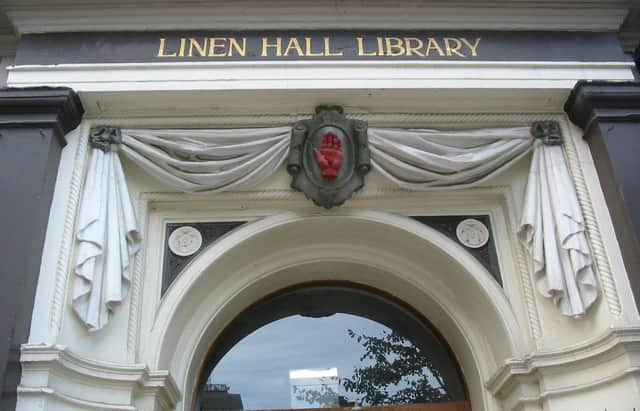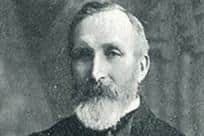How Belfast’s Linen Hall Library got its Robert Burns collection for a song


Thanks to Andrew Gibson, a scholarly businessman and bibliophile with a keen interest the poetry of Robert Burns, Thomas Moore and Allan Ramsay, the Linen Hall Library in Belfast has in the Gibson collection one of the finest collections of Burns material in the world outside Scotland.
Gibson was born on December 23 1841 in New Cumnock, Ayrshire, and was the eldest son of William Kennedy Gibson and Janet Gibson (née Black). William Kennedy Gibson was an agricultural labourer who married his employer’s daughter.
Advertisement
Hide AdAdvertisement
Hide AdThe family later moved to Pathhead in Midlothian where Andrew and his younger brother Peter worked as clerks at the nearby railway station. Andrew was 18-years-old when his mother died in 1859. Five years later his father married Janet Lapraik, the granddaughter of John Lapraik, a good friend of Robert Burns.


Possibly around the time of his father’s remarriage, Andrew moved to Glasgow to work as a shipping clerk for G & J Burns. Although not related to the poet, George and James Burns were two very ‘go-ahead’ brothers who were quick off the mark in replacing sailing ships with steam ships, running steamboats between Ardrossan and Belfast, Londonderry and Larne as their primary and principal business.
Andrew progressed steadily within the company and in 1881 he (and his family) moved to Belfast to take up post as manager of the company in the city. He spent the remainder of his life in the city. All his children married into the Belfast business community.
There was nothing exceptional in this as Kyle Hughes demonstrates in ‘Scots in Victorian and Edwardian Belfast: A Study in Elite Migration’. Furthermore, Scots, like Gibson, played key roles in shaping Belfast society. Some played key roles in its industrial development. Others were central to cultural, philanthropic, and religious initiatives. Such people were welcomed with open arms by the host community. Thus, Gibson succeeded in achieving a prominence in the commercial, cultural, and sporting life of the city.
Advertisement
Hide AdAdvertisement
Hide AdBy 1910 Gibson was agent both for the Burns and Cunard lines and between 1915 and 1925 he served on the Harbour Board.
In the sporting world, he was president of the Belfast Bowling Club and served as president of Cliftonville Football Club and vice-president of the Irish Football Association.
In the cultural world, Andrew Gibson was a founder member of the Belfast Harp Festival, a director of ‘The Ulster Journal of Archaeology’, president of the Belfast Burns Club, president of the Belfast Scottish Association and between 1894 and 1927 he was a governor of the Linen Hall Library and played an active role in the life of the library.
Robert Burns was one of his great passions. He sought to acquire every edition of Burns published and spared no effort in doing so. According to Frank Ferguson, John Erskine and Roger Dixon in ‘Commemorating and collecting Burns in the north of Ireland, 1844-1902’, Gibson’s collection contained 728 distinct editions which had been acquired over two decades.
Advertisement
Hide AdAdvertisement
Hide AdIn 1896 – the centenary year of Burns’ death – a Burns Exhibition was held in the galleries of The Royal Glasgow Institute of the Fine Arts in Sauchiehall Street. The quality of Gibson’s collection was heavily underscored by the fact that over 300 of his texts were loaned to the exhibition.
In 1900 Gibson temporarily found himself in straitened circumstance (apparently because his commissions from Cunard had dried up) and intended to dispose of his Burns collection. Friends and acquaintances approached him to ascertain if he would be willing to sell the entire collection to the city of Belfast, a proposition to which he readily agreed.
A provisional committee (whose membership included the lord mayor; Rev Dr Thomas Hamilton, president of Queen’s College, Belfast; Professor William Whitla; and Francis Joseph Biggar, the antiquarian) was set up to acquire the collection.
Enthusiastic support for the acquisition of the collection on behalf of the city was strongly in evidence at a special meeting under the chairmanship of the lord mayor at the Linen Hall Library on December 9 1900 and a subscription fund was established.
Advertisement
Hide AdAdvertisement
Hide AdThe collection was independently valued at £2,000 but Gibson generously indicated his willingness to accept half that amount subject to the proviso that the collection remained in Belfast. (By some calculations, Gibson was forgoing the equivalent of £86,000 today.)
The Linen Hall Library readily agreed to house the collection.
At a ceremony at the Linen Hall Library to mark the official transfer of the collection, Sir Otto Jaffe expressed ‘on behalf of all the inhabitants of Belfast and those of future generations their indebtedness to the committee’.
Subsequently, several items were presented to the library by Burns’s great-granddaughter, Mrs Eliza Everitt.
Advertisement
Hide AdAdvertisement
Hide AdThe Gibson collection consists primarily of books and other papers, but also some portraits, prints and ephemera but includes no Burns manuscripts.
While the library no longer aims to collect all Burnsiana, it aspires to acquire key reference works in relation to the bard.
Gibson’s Moore and Ramsay collections are held in Queen’s University. Frank Ferguson, John Erskine and Roger Dixon contend that Gibson’s interest in Burns owed as much to Victorian antiquarianism as it did to love of his favourite poet.
A Baptist, Andrew Gibson died on 23 June 1931.
William Kennedy Gibson, Andrew Gibson’s eldest son, also merits brief mention.
Advertisement
Hide AdAdvertisement
Hide AdA talented footballer, he played for Cliftonville as a schoolboy. Between 1894 and 1902 he was an Irish international, playing in 13 matches and captaining the team on four occasions. A solicitor by profession, he was a legal advisor to the IFA. He also had political ambitions, being elected for Clifton ward to Belfast Corporation in 1909 and served until 1920. In the general election of 1918, he intended to contest Belfast Duncairn but stood aside for Sir Edward Carson. In 1929 he unsuccessfully contested the Ballynafeigh seat in the Northern Ireland House of Commons as an independent unionist.